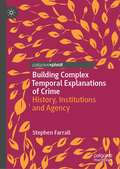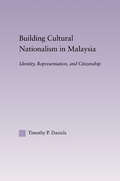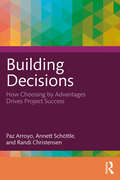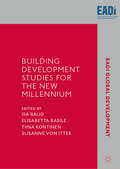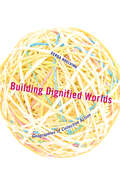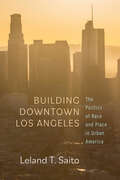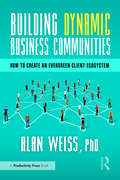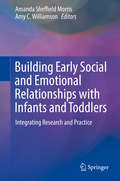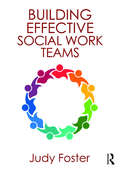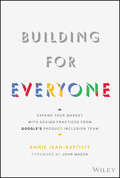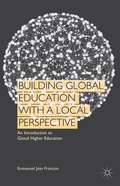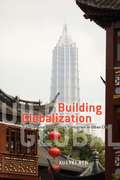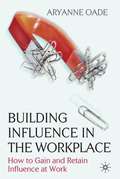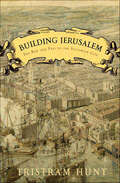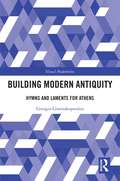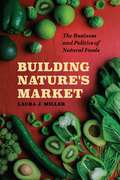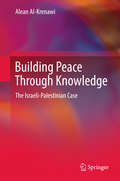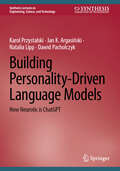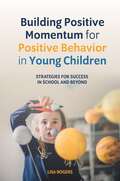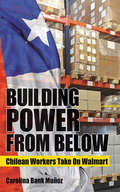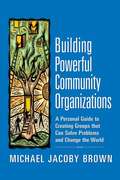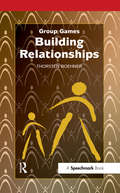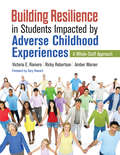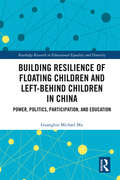- Table View
- List View
Building Complex Temporal Explanations of Crime: History, Institutions and Agency (Critical Criminological Perspectives)
by Stephen FarrallThis book seeks to bring understanding of both complexity and temporality into criminology. It outlines why these are important in criminological models of causation and explanation and explores them by drawing on theories and approaches in political science, comparative history, social theory and systems analyses. It discusses what is meant by complexity and introduces historical institutionalism (which is rarely used in criminology) to criminological audiences; it introduces what is known as ‘why-because’ analyses to the social sciences. This style of thinking is used to explore the causes of major transportation accidents (such as aeroplane or ferry disasters) and involves the integration of structural, organisational and agentic inputs in accounting for such disasters. Chapters on realistic evaluation, theories of structuration and agency, and research design and research methods are included with an example project based on the author's recent studies of Thatcherism which shows how these theories can be applied to empirical data. This book speaks to those interested in criminology, sociology, political science, research methods and the wider social sciences.
Building Cultural Nationalism in Malaysia: Identity, Representation and Citizenship (East Asia: History, Politics, Sociology and Culture)
by Timothy P. DanielsThis text contains an examination of processes of cultural citizenship in peninsular Malaysia. In particular, it focuses upon the diverse residents of the southwestern state of Melaka and their negotiations of belonging and incorporation in Malaysian society. Following political independence and the formation of the Federation of Malaysia in 1957 Malaysian citizenship was extended to most members of these diverse social identities. In this post-colonial context, Timothy P. Daniels examines how public celebrations and representations, religious festivals, and patterns of social relations are connected to processes of inclusion and exclusion.
Building Decisions: How Choosing by Advantages Drives Project Success
by Paz Arroyo Annett Schöttle Randi ChristensenDecision-making is critical. Leaders make decisions daily, often hyper-focusing on cost at the expense of value for society and with negative impacts on the environment and the climate. Project teams are poorly equipped to make decisions and prefer to avoid conflicts instead of having a healthy discussion based on different perspectives. We need to learn ways of making decisions that give better outcomes.Building Decisions presents a framework and practical guidelines for everyday decision-making. The authors introduce the reader to a specific decision-making system, Choosing By Advantages (CBA), and explain the CBA Tabular decision-making method. Providing detailed explanations using relatable examples such as choosing a phone and renovating a kitchen, the book also uses case studies of large construction projects from the authors’ professional careers, including a museum in San Francisco, a tunnel in England, and the main railway station in Munich, to explain the CBA method. These varied examples will help the reader to improve their own decision-making process through critical reflection.Written by three curious experts who founded a research lab focusing on decision-making and want the world to make better decisions. Paz, Annett, and Randi have published dozens of peer-reviewed papers and trained multiple practitioners and engineers on how to make collaborative decisions using CBA. They have designed this book to help professionals, leaders, anyone, and everyone make better and more inclusive decisions and achieve better outcomes.
Building Development Studies for the New Millennium (EADI Global Development Series)
by Isa Baud Elisabetta Basile Tiina Kontinen Susanne Von ItterThis book brings together multiple critical assessments of the current state and future visions of global development studies. It examines how the field engages with new paradigms and narratives, methodologies and scientific impact, and perspectives from the Global South. The authors focus on social and democratic transformation, inclusive development and global environmental issues, and implications for research practices. Leading academics provide an excellent overview of recent insights for post-graduate students and scholars in these research areas.
Building Dignified Worlds: Geographies of Collective Action (Diverse Economies and Livable Worlds #1)
by Gerda RoelvinkBuilding Dignified Worlds examines how contemporary collectives are designing alternative economies. Contemporary collectives differ markedly from previous groups associated with revolutionary politics. Instead of assembling large groups of workers around labor issues, these new collectives creatively arrange diverse peoples, animals, natural environments, and technologies around economic concerns. Like older forms of leftist organizing, these collectives seek to bring about change. However, rather than working to overthrow and replace an underlying capitalist system with an equally totalizing alternative like socialism, they experiment with new forms of economic life. This book explores how socially and politically concerned groups actually establish alternative economies.Building Dignified Worlds investigates social movements that do not simply protest but actively forge functional alternatives. The market model described by many scholars and activists as the enemy of these recent social movements rarely exists in today&’s world. As Gerda Roelvink notes, current markets are better conceptualized as dynamic social networks open to intervention by innovative social movements. Radical scholars have theorized social transformation as a performative act. They have provided extensive analysis of how discourse shapes the world through language and is materialized in bodies and practices. Until now, though, little has been written about the geographical nature of collective associations &“performing&” new worlds.Roelvink takes actor network and performativity theories of action as starting points for thinking about how contemporary collectives bring the new into being. This approach enables an understanding of how collectives initiate change and begins to map the forces through which they operate. Roelvink&’s work reveals, in particular, how the relational and geographical nature of performative action is central to the ways in which hybrid collectives strive to create alternative economies.
Building Downtown Los Angeles: The Politics of Race and Place in Urban America
by Leland T. SaitoFrom the 1970s on, Los Angeles was transformed into a center for entertainment, consumption, and commerce for the affluent. Mirroring the urban development trend across the nation, new construction led to the displacement of low-income and working-class racial minorities, as city officials targeted these neighborhoods for demolition in order to spur economic growth and bring in affluent residents. Responding to the displacement, there emerged a coalition of unions, community organizers, and faith-based groups advocating for policy change. In Building Downtown Los Angeles Leland Saito traces these two parallel trends through specific construction projects and the backlash they provoked. He uses these events to theorize the past and present processes of racial formation and the racialization of place, drawing new insights on the relationships between race, place, and policy. Saito brings to bear the importance of historical events on contemporary processes of gentrification and integrates the fluidity of racial categories into his analysis. He explores these forces in action, as buyers and entrepreneurs meet in the real estate marketplace, carrying with them a fraught history of exclusion and vast disparities in wealth among racial groups.
Building Dynamic Business Communities: How to Create an Evergreen Client Ecosystem
by Alan WeissThis book is based on the author’s lengthy experience in creating communities and helping organizations and individuals thereby providing for evangelism and sustained growth. The result is dynamic marketing and sales at low, or no, cost of acquisition. Thus, communities are powerful sources for business owners, executives, and entrepreneurs. The research and literature supporting communities and the power of referral, peer-level influence, and normative buying pressures is enormous. This is not an internet-based or “pyramid marketing” initiative, which is based on a zero-sum game and is unethical or illegal. These communities are both “live” and remote and become perpetual-motion sales machines. Most organizations have the raw materials for successful communities, but they don’t realize it, nor do they know how to go about creating them.This work is the remedy. The author believes that many people are still “lonely” and isolated post-pandemic with remote work or hybrid work. Communities can embrace these people to build camaraderie and higher performance. The key benefits include gaining value for merely bringing people together who normally would never have met; providing viral marketing among members, which is effective 24/7; easily creating global communities to expand business; and dramatically building brands. Essentially, this book will enable the reader to use over a dozen pragmatic, sequential steps to organize resources, publicize, gain members, provide instant value, and assemble critical mass for the community to continually add members and perpetuate itself in “The chain reaction of attraction”®.
Building Early Social and Emotional Relationships with Infants and Toddlers: Integrating Research and Practice
by Amanda Sheffield Morris Amy C. WilliamsonThis book provides a comprehensive overview of the process of building healthy early social and emotional relationships with infants from a developmental perspective. The book synthesizes current research on the contextual influences of attachment, family relationships, and caregiving practices on social-emotional development. Chapters examine the processes of socioemotional development—particularly in relationships with parents, other family members, and peers—and identify areas for promoting healthy attachments and resilience, improving caregiving skills, and intervening in traumatic and stressful situations. Chapters also present empirically-supported intervention and prevention programs focused on building early relationships from birth through three years of age. The book concludes with future directions for supporting infant mental health and its vital importance as a component of research, clinical and educational practice, and child and family policy. Topics featured in this book include:The effect of prenatal and neonatal attachment on social and emotional development.The impact of primary relationships and early experiences in toddlerhood.Toddler autonomy and peer awareness in the context of families and child care.Supporting early social and emotional relationships through The Legacy for Children™ Intervention.How to build early relationship programming across various cultures. Building Early Social and Emotional Relationships with Infants and Toddlers is a must-have reference for researchers, clinicians and professionals, and graduate students in the fields of infant mental health, developmental psychology, pediatrics, public health, family studies, and early childhood education.
Building Effective Social Work Teams
by Judy FosterHow has social work changed over the years? What are some of the best social work teams doing differently to meet the complex practical and emotional needs of service users? What practical tools and approaches can social work managers implement with their teams? Dr. Judy Foster examines good social work practice and the supporting factors that are essential to underpin social work teams – coherent policies; well-qualified and motivated staff; good management support structures; delegated autonomy and discretion for social workers; and mental space to allow reflective and creative problem solving. She illustrates the dilemmas and rewards of social work relationships through personal stories from her own career as a social worker, manager and teacher - and interviews with social workers and managers. These examples show the relationship between ‘doing’ something for someone and ‘being’ emotionally present to empower a service user to manage better. The book is intended to help social work managers improve the support environment for their teams – and hence their effectiveness – and to inform students and others in related professions interested in learning more about social work. It will also have a wide appeal to an international social work readership.
Building For Everyone: Expand Your Market With Design Practices From Google's Product Inclusion Team
by Annie Jean-BaptisteDiversity and Inclusion to build better products from the front lines at Google Establishing diverse and inclusive organizations is an economic imperative for every industry. Any business that isn’t reaching a diverse market is missing out on enormous revenue potential and the opportunity to build products that suit their users' core needs. The economic “why” has been firmly established, but what about the “how?” How can business leaders adapt to our ever-more-diverse world by capturing market share AND building more inclusive products for people of color, women and other underrepresented groups? The Product Inclusion Team at Google has developed strategies to do just that and Building For Everyone is the practical guide to following in their footsteps. This book makes publicly available for the first time the same inclusive design process used at Google to create user-centric award-winning and profitable products. Author and Head of Product Inclusion Annie Jean-Baptiste outlines what those practices look like in industries beyond tech with fascinating case studies. Readers will learn the key strategies and step-by-step processes for inclusive product design that limits risk and increases profitability. Discover the questions you should be asking about diversity and inclusion in your products for marketers, user researchers, product managers and more. Understand the research the Product Inclusion team drove to back up their practices Learn the “ABCs of Product Inclusion” to build inclusion into your organization’s culture Leverage the product inclusion suite of tools to get your organization building more inclusively and identifying new opportunities. Read case studies to see how product inclusion works across industries and learn what doesn't work. Building For Everyone will show you how to infuse your business processes with inclusive design. You’ll learn best practices for inclusion in product design, marketing, management, leadership and beyond, straight from the innovative Google Product Inclusion team.
Building Global Education with a Local Perspective
by Emmanuel Jean FrancoisBuilding Global Education with a Local Perspective introduces the concepts, theories, and practices associated with glocal higher education, based on the ideas of "think globally, act locally", and "think locally, act globally". Jean Francois' outline of glocal higher education suggests frameworks that can serve as alternatives to the limitations of the imperialist ambitions of global education. Using templates, case studies, illustrations, and activities, Jean Francois challenges the critical thinking of scholars and policy makers, and suggest original strategies to plan and implement these programs and projects in international, comparative, and global education.
Building Globalization: Transnational Architecture Production in Urban China
by Xuefei RenFrom the years 2004 to 2008, Beijing and Shanghai witnessed the construction of an extraordinary number of new buildings, many of which were designed by architectural firms overseas. Combining ethnographic fieldwork, historical research, and network analysis, Building Globalization closely scrutinizes the growing phenomenon of transnational architecture and its profound effect on the development of urban space. Roaming from construction sites in Shanghai to architects’ offices in Paris, Xuefei Ren interviews hundreds of architects, developers, politicians, residents, and activists to explore this issue. She finds that in the rapidly transforming cities of modern China, iconic designs from prestigious international architects help private developers to distinguish their projects, government officials to advance their careers, and the Chinese state to announce the arrival of modern China on the world stage. China leads the way in the globalization of architecture, a process whose ramifications can be felt from Beijing to Dubai to Basel. Connecting the dots between real estate speculation, megaproject construction, residential displacement, historical preservation, housing rights, and urban activism, Building Globalization reveals the contradictions and consequences of this new, global urban frontier.
Building Influence in the Workplace
by Aryanne OadeIntroduces you to a valuable set of tools enabling you to build influence, promote your interests and get buy-in to your plans and proposals. The book will enable you to identify your own workplace values and those of your key colleagues and understand how to retain the influence you have already gained and stand by your values under pressure.
Building Jerusalem: The Rise and Fall of the Victorian City
by Tristram HuntFrom Manchester's deadly cotton works to London's literary salons, a brilliant exploration of how the Victorians created the modern city Since Charles Dickens first described Coketown in Hard Times, the nineteenth-century city, born of the industrial revolution, has been a byword for deprivation, pollution, and criminality. Yet, as historian Tristram Hunt argues in this powerful new history, the Coketowns of the 1800s were far more than a monstrous landscape of factories and tenements. By 1851, more than half of Britain's population lived in cities, and even as these pioneers confronted a frightening new way of life, they produced an urban flowering that would influence the shape of cities for generations to come. Drawing on diaries, newspapers, and classic works of fiction, Hunt shows how the Victorians translated their energy and ambition into realizing an astonishingly grand vision of the utopian city on a hill—the new Jerusalem. He surveys the great civic creations, from town halls to city squares, sidewalks, and even sewers, to reveal a story of middle-class power and prosperity and the liberating mission of city life. Vowing to emulate the city-states of Renaissance Italy, the Victorians worked to turn even the smokestacks of Manchester and Birmingham into sites of freedom and art. And they succeeded—until twentieth-century decline transformed wealthy metropolises into dangerous inner cities. An original history of proud cities and confident citizens, Building Jerusalem depicts an unrivaled era that produced one of the great urban civilizations of Western history.
Building Modern Antiquity: Hymns and Laments for Athens (Visual Modernities)
by Georgia GiannakopoulouThis book considers post-19th-century Athens as a unique instance of a secret side of metropolitan capitalism. With a focus on modern antiquity as the hidden element of the dialectic between the past and the present, it suggests that the sociological study of one of the great European capital cities – a city not intended as a modern capital – and its architectural representations may expose part of the veiled processes of the reconstruction of the past, thus shedding light on the abuse of antiquity for the celebration of European capitalist metropolitan modernity. From the "glorious" white-marble cityscape of the 19th century that aimed at "re-enchanting" metropolitan modernity, to the inglorious grey reinforced-concrete 21st-century metropolis, modern Athens exposes the battle between the modern and a modern image of antiquity: a false, socially constructed historiography born of the dialectics between the ancient and the modern, the new and the old, collective memory and collective forgetting. As such, The Building of a Modern Antiquity will appeal to scholars of sociology with interests in social and critical theory, urban studies, sociology of architecture, and visual sociology.
Building Nature's Market: The Business and Politics of Natural Foods
by Laura J. MillerFor the first 150 years of their existence, “natural foods” were consumed primarily by body builders, hippies, religious sects, and believers in nature cure. And those consumers were dismissed by the medical establishment and food producers as kooks, faddists, and dangerous quacks. In the 1980s, broader support for natural foods took hold and the past fifteen years have seen an explosion—everything from healthy-eating superstores to mainstream institutions like hospitals, schools, and workplace cafeterias advertising their fresh-from-the-garden ingredients. Building Nature’s Market shows how the meaning of natural foods was transformed as they changed from a culturally marginal, religiously inspired set of ideas and practices valorizing asceticism to a bohemian lifestyle to a mainstream consumer choice. Laura J. Miller argues that the key to understanding this transformation is to recognize the leadership of the natural foods industry. Rather than a simple tale of cooptation by market forces, Miller contends the participation of business interests encouraged the natural foods movement to be guided by a radical skepticism of established cultural authority. She challenges assumptions that private enterprise is always aligned with social elites, instead arguing that profit-minded entities can make common cause with and even lead citizens in advocating for broad-based social and cultural change.
Building Peace Through Knowledge: The Israeli-Palestinian Case
by Alean Al-KrenawiThis groundbreaking volume documents a comprehensive peacebuilding initiative in addressing the Israeli-Palestinian conflict and reviews the broad theoretical base underlying these efforts. Theory chapters discuss intrinsic peace-related concepts, including the nature of conflict, elements of individual and group identity, the long-term psychological effects of prolonged political hostilities, and the mechanisms of reconciliation and inclusiveness. Central to the coverage is the ambitious Building Peace through Knowledge Project, a four-year multidisciplinary program featuring a diverse palette of professional and community interventions to reduce the occurrence and trauma of political violence. The author reveals powerful insights connecting knowledge to peacebuilding by analyzing: #65533; The relationships between attitudes and ideology in intergroup conflict. #65533; The psychosocial impact of political violence among Israelis and Palestinians. #65533; The literature on people-to-people interventions (P2Ps) in conflict reduction. #65533; The roles of forgiveness, reconciliation, and fairness in conflict resolution. #65533; The methodology and findings of the Building Peace through Knowledge Project. #65533; The potential of knowledge-based interventions in building sustainable peace in other regions. Practitioners, mental health professionals, and scholars with interests in multicultural mental health, cross-cultural psychology, political violence, and peace education will look to Building Peace through Knowledge as an ideabook, a mission statement, and a road map toward a more stable world.
Building Personality-Driven Language Models: How Neurotic is ChatGPT (Synthesis Lectures on Engineering, Science, and Technology)
by Karol Przystalski Jan K. Argasiński Natalia Lipp Dawid PacholczykThis book provides an innovative exploration into the realm of artificial intelligence (AI) by developing personalities for large language models (LLMs) using psychological principles. Aimed at making AI interactions feel more human-like, the book guides you through the process of applying psychological assessments to AIs, enabling them to exhibit traits such as extraversion, openness, and emotional stability. Perfect for developers, researchers, and entrepreneurs, this work merges psychology, philosophy, business, and cutting-edge computing to enhance how AIs understand and engage with humans across various industries like gaming and healthcare. The book not only unpacks the theoretical aspects of these advancements but also equips you with practical coding exercises and Python code examples, helping you create AI systems that are both innovative and relatable. Whether you’re looking to deepen your understanding of AI personalities or integrate them into commercial applications, this book offers the tools and insights needed to pioneer this exciting frontier.
Building Positive Momentum for Positive Behavior in Young Children: Strategies for Success in School and Beyond
by Lisa RogersProviding practical solutions to common behavioral problems, this book shows how to use the positive momentum approach to encourage long-term positive behaviour among children aged 3-9. Covering issues such as what to do when a child avoids doing work, when they engage in rough play, and when they won't stay in their seat, this book includes targeted behavioral strategies that start with the underlying foundations of behaviour and result in lasting positive change. Through real life examples, the book shows how educators can be role models for children, and how school staff can collaborate with families for success beyond the classroom. The book also includes information specific to working with children with special needs. Accompanying behaviour charts and goal mapping resources are available to download to help with tracking a child's progress.
Building Power from Below: Chilean Workers Take On Walmart
by Carolina Bank MuñozA story that involves as its main players "workers" and "Walmart" does not usually have a happy ending for labor, so the counternarrative offered by Building Power from Below is must reading for activists and union personnel as well as scholars. In 2008 Walmart acquired a controlling share in a large supermarket chain in Santiago, Chile. As part of the deal Walmart had to accept the unions that were already in place. Since then, Chilean retail and warehouse workers have done something that has seemed impossible for labor in the United States: they have organized even more successful unions and negotiated unprecedented contracts with Walmart.In Building Power from Below, Carolina Bank Muñoz attributes Chilean workers’ success in challenging the world’s largest corporation to their organizations’ commitment to union democracy and building strategic capacity. Chilean workers have spent years building grassroots organizations committed to principles of union democracy. Retail workers’ unions have less structural power, but have significant associational and symbolic power. Their most notable successes have been in fighting for respect and dignity on the job. Warehouse workers by contrast have substantial structural power and have achieved significant economic gains. While the model in Chile cannot necessarily be reproduced in different countries, we can gain insights from the Chilean workers’ approaches, tactics, and strategies.
Building Powerful Community Organizations: A Personal Guide to Creating Groups that can Solve Problems and Change the World
by Michael Jacoby BrownThis book is intended for individuals who want to start, strengthen, or revitalize a group to address a community issue, this indispensable guide includes a series of practical steps that help build a successful community orgranization and offers sample cases that more clearly illustrate each step. In addition to addressing common problems that are often encountered, the book also discusses how to run engaging meetings, recruit and motivate community members, raise necessary funds, and turn a passion into a powerful tool for social change.
Building Relationships (Group Games)
by Lilo Seelos Thorsten BoehnerGroup Games: Building Relationships Thorsten Boehner - A comprehensive collection of 140 games and activities to foster personal development; improve social communication skills; and strengthen group dynamics. Full of practical and creative ideas that can be implemented with minimal preparation and equipment. 140 games and activities to foster personal development; improve social communication skills; and strengthen group dynamics. Full of practical and creative ideas that can be implemented with minimal preparation and equipment. Suitable for all ages, the games will increase self- and other-awareness; improve recognition of one's own limits as well as awareness of the limits of others; encourage better teamwork skills; and increase flexibility as participants gain new experiences in a playful and safe environment. Includes: Group gel activities; Warm-up activities; Exercises for building trust and awareness; Imagination and improvisation; Closing exercises; Special exercises and tips for amateur dramatics lovers.
Building Resilience in Students Impacted by Adverse Childhood Experiences: A Whole-Staff Approach
by Victoria E. Romero Ricky Robertson Amber N. WarnerUse trauma-informed strategies to give students the skills and support they need to succeed in school and life Nearly half of all children have been exposed to at least one adverse childhood experience (ACE), such as poverty, divorce, neglect, homelessness, substance abuse, domestic violence, or parent incarceration. These students often enter school with behaviors that don’t blend well with the typical school environment. How can a school community come together and work as a whole to establish a healthy social-emotional climate for students and the staff who support them? This workbook-style resource shows K-12 educators how to make a whole-school change, where strategies are integrated from curb to classroom. Readers will learn how to integrate trauma-informed strategies into daily instructional practice through expanded focus on: The different experiences and unique challenges of students impacted by ACEs in urban, suburban, and rural schools, including suicidal tendencies, cyberbullying, and drugs Behavior as a form of communication and how to explicitly teach new behaviors How to mitigate trauma and build innate resiliency through a read, reflect, and respond model Let this book be the tool that helps your teams move students away from the school-to-prison pipeline and toward a life rich with educational and career choices. "I cannot think of a book more needed than this one. It gives us the tools to support our students who have the most need while practicing the self-care necessary to continue to serve them." —Lydia Adegbola, Chair of English Department New Rochelle High School, NY "This book highlights the impact of trauma on children and the adults who work with them, while providing relevant and practical strategies to understand and address it through reflective practices." —Marine Avagyan, Director, Curriculum and Instruction Saugus Union School District, Sunland, CA
Building Resilience in Students Impacted by Adverse Childhood Experiences: A Whole-Staff Approach
by Victoria E. Romero Ricky Robertson Amber N. WarnerUse trauma-informed strategies to give students the skills and support they need to succeed in school and life Nearly half of all children have been exposed to at least one adverse childhood experience (ACE), such as poverty, divorce, neglect, homelessness, substance abuse, domestic violence, or parent incarceration. These students often enter school with behaviors that don’t blend well with the typical school environment. How can a school community come together and work as a whole to establish a healthy social-emotional climate for students and the staff who support them? This workbook-style resource shows K-12 educators how to make a whole-school change, where strategies are integrated from curb to classroom. Readers will learn how to integrate trauma-informed strategies into daily instructional practice through expanded focus on: The different experiences and unique challenges of students impacted by ACEs in urban, suburban, and rural schools, including suicidal tendencies, cyberbullying, and drugs Behavior as a form of communication and how to explicitly teach new behaviors How to mitigate trauma and build innate resiliency through a read, reflect, and respond model Let this book be the tool that helps your teams move students away from the school-to-prison pipeline and toward a life rich with educational and career choices. "I cannot think of a book more needed than this one. It gives us the tools to support our students who have the most need while practicing the self-care necessary to continue to serve them." —Lydia Adegbola, Chair of English Department New Rochelle High School, NY "This book highlights the impact of trauma on children and the adults who work with them, while providing relevant and practical strategies to understand and address it through reflective practices." —Marine Avagyan, Director, Curriculum and Instruction Saugus Union School District, Sunland, CA
Building Resilience of Floating Children and Left-Behind Children in China: Power, Politics, Participation, and Education (Routledge Research in Educational Equality and Diversity)
by Guanglun Michael MuThe past two decades have seen exponential growth of urbanisation and migration in China. Emerging from this growth is a population of floating and left-behind children which is estimated to be approaching 100 million. Due to their increasing risks of undesirable educational and social, as well as health and psychological, outcomes, there is a great urgency to help floating children and left-behind children beat the odds. This book offers an analysis of how oscillations of government discourse have come to shape central and local educational policies regarding the schooling of these children. It also delves into child and youth resilience in this unique migration context, examining what can be done to build up resilience of floating and left-behind children. In this vein, the book will complement current knowledge and advance context- and culture-specific understandings of child and youth resilience through both school-based and community-based approaches. The book aims to answer a fundamental question: How to help floating children and left-behind children become responsive and resilient to structural deficiencies and dynamics in the migration context of China? This is important reading for scholars, school professionals, community workers, and policy makers to better address the social and educational resilience and wellbeing of floating and left-behind children.
